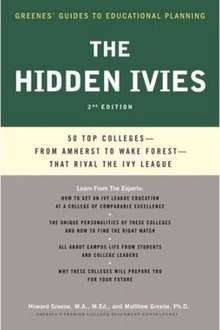Hidden Ivies
Hidden Ivies is a college educational guide with the most recent edition, The Hidden Ivies, 3rd Edition: 63 of America's Top Liberal Arts Colleges and Universities, published in 2016. It focuses on college admissions in the United States. The authors define both the title of this book as well as their goals in writing it as: "to create greater awareness of the small, distinctive cluster of colleges and universities of excellence that are available to gifted college-bound students."[1] In the introduction, the authors further explain their aim by referring specifically to "the group historically known as the 'Little Ivies' (including Amherst, Bowdoin, Middlebury, Swarthmore, Wesleyan, and Williams)" which the authors say have "scaled the heights of prestige and selectivity and also turn away thousands of our best and brightest young men and women."[1][2]
 Cover of 2009 edition | |
| Author | Howard Greene and Matthew Greene |
|---|---|
| Country | United States |
| Language | English |
| Genre | Education |
| Publisher | New York City : Cliff Street Books |
Publication date | 2000 (first); 2009 (second); 2016 (third) |
| Media type | paperback |
| Pages | 317 p. ; 24 cm. |
| ISBN | 0-06-095362-4 |
| OCLC | 44509154 |
| 378.1/61 21 | |
| LC Class | LB2350.5 G74 2000 |
In this book, the authors (using the same criteria often used to evaluate Ivy League schools) discuss 63 American schools that are small in size and are either liberal arts colleges or universities that emulate them.
Overview
Hidden Ivies discusses the college admissions process and attempts to evaluate 63 colleges in comparison to Ivy League colleges. The schools are examined based on academics, admissions process, financial aid, and student experiences. The book argues the importance of a liberal arts education and goes on to inquire about the qualities of Ivy League schools in general, and how such qualities apply to higher education.
Inclusions
Northeast
- Amherst College
- Barnard College
- Bates College
- Boston College
- Bowdoin College
- Brandeis University
- Bryn Mawr College
- Bucknell University
- Colby College
- Colgate University
- College of the Holy Cross
- Connecticut College
- Dickinson College
- Fordham University
- Franklin & Marshall College
- Hamilton College
- Haverford College
- Johns Hopkins University
- Lafayette College
- Lehigh University
- Middlebury College
- Mount Holyoke College
- Skidmore College
- Smith College
- Swarthmore College
- Trinity College
- Tufts University
- Union College
- University of Rochester
- Vassar College
- Villanova University
- Wellesley College
- Wesleyan University
- Williams College
South
Midwest
West
See also
- Black Ivy League — A list of Historically Black Colleges or Universities that provide Ivy quality education in a predominantly black environment
- Colby-Bates-Bowdoin Consortium — Athletic grouping of three Maine liberal arts colleges, that are generally considered to give Ivy League caliber education.
- Jesuit Ivy — Complimentary use of "Ivy" to characterize Boston College
- Little Three — Three liberal arts colleges in New England (Amherst, Wesleyan, and Williams), in contrast to the Big Three of the Ivy League (Harvard, Yale, and Princeton)
- Little Ivies — Group of U.S. liberal arts colleges that parallel the Ivy League in some respects
- Public Ivies — Group of public U.S. universities thought to "provide an Ivy League collegiate experience at a public school price"
- Seven Sisters — Historically, these were women's colleges each of which had a close tie to an Ivy League school.
- Southern Ivies — Complimentary use of "Ivy" to characterize excellent universities in the U.S. South
- Transfer admissions in the United States
- College admissions in the United States
Notes
- Greene, Howard; Greene, Matthew. "Excerpt from Greenes' Guides to Educational Planning: The Hidden Ivies Thirty Colleges of Excellence by Howard Greene". HarperCollins.com. Retrieved 2011-08-17.
- Greene, Howard and Matthew Greene (2000) Greenes' Guides to Educational Planning: The Hidden Ivies: Thirty Colleges of Excellence, HarperCollins, ISBN 0-06-095362-4, book description at HarperCollins.com Archived 2005-03-21 at the Wayback Machine
References
- Howard Greene; Mathew W. Greene (2000). Greenes' Guides to Educational Planning: The Hidden Ivies: Thirty Colleges of Excellence. New York: HarperCollins. ISBN 0-06-095362-4.
- Howard Greene; Mathew W. Greene (2009). Greenes' Guides to Educational Planning: The Hidden Ivies: 50 Top Colleges - from Amherst To Williams - that Rival the Ivy League. New York: HarperCollins. ISBN 0-06-172672-9.
- Howard Greene; Mathew W. Greene (2016). The Hidden Ivies, 3rd Edition: 63 of America's Top Liberal Arts Colleges and Universities. New York: Collins Reference. ISBN 0062420909.